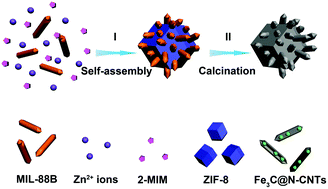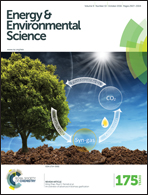A dual-metal–organic-framework derived electrocatalyst for oxygen reduction†
Abstract
High-performance electrocatalysts for the oxygen reduction reaction are indispensable in many electrochemical energy storage and conversion technologies. However, the lack of efficient and inexpensive catalysts or catalyst systems that can compete with noble metal catalysts hinders their large-scale industrial applications. As an important class of porous materials, metal–organic frameworks (MOFs) with systematically tailored structures and compositions have recently been suggested as promising precursors for the preparation of diverse functional materials. Here we report a dual-MOF confined-pyrolysis approach for the preparation of iron carbide nanoparticle-embedded carbon nanotube assemblies. Starting from a novel MOF-in-MOF precursor consisting of a Zn-based MOF polyhedron host and many engulfed Fe-based MOF nanorods, a complex structured composite material constructed from iron carbide nanocrystallite-embedded carbon nanotubes encapsulated in a porous carbon matrix is successfully prepared. We further demonstrate that the as-derived composite material manifests remarkable electrocatalytic performance for the oxygen reduction reaction in an alkaline electrolyte. The present strategy significantly expands the toolbox for the design and synthesis of MOF-derived functional materials for a wide range of applications.



 Please wait while we load your content...
Please wait while we load your content...